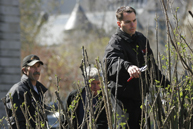In focus
Eric Champagne: Putting down roots

Groundskeepers Normand Lefebvre and Patrick Jonca look on as horticulturalist Eric Champagne tends to some of McGill's greenery.
Owen Egan
Ask Eric Champagne what his favourite tree on campus is and you'll have to wait a little for the reply. He's someone that likes all of downtown McGill's 900-odd trees — minus, of course, the scrappy Manitoba maple. But even for the infamous weed-tree he has praise: "What better tree to prevent the dirt and bits of rock from eroding from the ravine just behind the Wong Building?" he says as we walk north toward Tomlinson Square, between the Genomics and Trottier buildings.
Eventually, however, he comes up with his favourites. "I'd have to say that couple of Kentucky coffee trees across the street from the Lyman Duff Building, behind one of those McGill houses on Pine," he ventures. With their tall straight trunks and black branches that look as if on a Hallowe'en night they could swoop you off the sidewalk, these twin trees are impressive, but only to those who know where they are.
They're rather like Champagne himself. He's impressive but doesn't seek the limelight. At every turn during the tour he gave me of McGill's grounds, Champagne, McGill's first horticulturalist, deflected attention away from himself and toward the busy groundsmen who are preparing the grounds for convocation.
At 35, he's younger than the crew out today trimming the grass and thinning the roses and it's obvious that he commands their respect. "Dix-neuf, c'est bon?" asks Roy Whitfield of the length he should mow the grass in front of the Strathcona Anatomy and Dentistry Building. "Oui, c'est bien," Champagne says.
Champagne shows me around Tomlinson Square, which was created two summers ago. "We've got ironwood trees growing over in this shady corner," he says, getting out his Trees in Canada guidebook to check the name in English. "They don't mind the shade."
Part of Champagne's mandate is to make the university's landscape less taxing on the budget, human labour and the environment. "Before Champagne came," says Brian Karasick, secretary of the Gardens and Grounds Committee, "there was no long-term plan. Since he's come on board, you can see how nice the campus looks."
The cheerful combination of the yellow daffodils and orange tulips alongside the south wall of Morris Hall are a case in point and the flowers will return every spring. Champagne has also reduced the need for water and weed control by having his crew put cedar mulch around the shrubs and flowers, and, gradually, he's reducing the need for annual flowers by replacing some with perennials. He's also switched from chemical fertilizers to compost. "With the organic methods, there are no instant results," he warns. "You have to wait for the long term."
Similarly, in the orchard behind the Lady Davis Building, planted just last summer, no spray will be used on the 18 pear, plum or apple trees. Planting an orchard was fellow grounds supervisor Angelo Tambasco's idea — as a way to repossess a spot that had become a dog park. "We both like fruit trees," says Champagne, examining the flowers on the young trees, "and we thought they'd be a good way to attract students."
Adding new life to the McGill landscape is what pleases Champagne most in his work. "It's always great to see the plant or tree growing and establishing itself," he says, adding that he looks forward to learning about those tree men and women who came before him and planted such rare trees as the tulip tree, soon to bloom in the dell beside the Redpath Museum, and the red-trunked dawn redwood in front of the Stewart Biology Building.
When asked what arboreal legacy he would like to leave, Champagne ponders, then settles on "some evergreens, because there aren't many on campus.
"I'd like to plant some eastern red cedars but they're not easy to find."
— Bronwyn Chester
 |
||||
|
"Scholars have argued for a long time over this, and it now seems that 616 was the original number of the beast." |
||||
Environmentalism: alive and kicking

Tzigane
A recent issue of The Economist wrote approvingly of an essay on the death of environmentalism that described the green movement as an effete special interest group. It is a safe bet that many at McGill would beg to differ.
At a symposium hosted by the McGill School of Environment (MSE) on May 2 and 3, colleagues from the university's faculties and research centres came together to share ideas and to forge new areas of collaboration on topics related to the environment. The two-day event reflected the breadth of McGill's environmental knowledge, and offered poster displays and over two dozen presentations. One moderator described it as a "delightful smorgasbord of ideas."
Marilyn Scott, acting director of the MSE, said, "Our main goal is to stimulate an interest in getting interdisciplinary teams together to pursue their research interests. Everyone's very keen to talk about research, which is what they love."
The interdisciplinary event was the second of its kind, the first having been held two years earlier. "The very diversity has been a fixture," said Scott. "There's everything from issues of justice, to air pollution, to green chemistry, to management of biodiversity."
Scott's observations were reflected in the series of 10-minute presentations on everything from social justice in teaching, to clean mining technology. Speakers brought up case studies from around the world, including one from the nearby waters of Lake Champlain, and another from far-off mega-cities in Pakistan and Bangladesh.
One professor credited the event with allowing him to discover a colleague in an adjacent building with whom he shared common research interests.
Although the symposium showed how the MSE has become a model for cross-disciplinary research and intra-university collaboration, it has not always been this way.
The school was born in the ‘90s, when McGill was frequently confronted with shrinking resources and budget squabbles. Professor Martin Lechowicz, speaking at the event, noted that such times are typically characterized by a "circle the wagons" mentality in faculties and departments. Therefore, the task of creating a new cross-disciplinary initiative in this context was a challenge, he noted, and he lauded the work of outgoing deans Alan Shaver and Deborah Buszard in ensuring the viability of the MSE.
"It wouldn't have happened without the two of them getting it started, and it wouldn't have continued," Lechowicz said.
Shaver and Buszard received a tribute at the event, and reflected on the school's early ups and downs. The latter recalled early heated discussions with her counterpart over the location of the school, and commented on how the MSE has been transformed from an early experiment into a great success. Shaver, too, reflected on the school's transitions, and spoke about the impact it has had on the campus as a whole.
"I'm particularly proud of the way these students and professors have changed McGill University," he said. "They've changed the way to look at teaching and interdisciplinary scholarship."
At the symposium, the MSE publicized a new seed grant program for professors who work with one another to promote new environmental ideas. Available to teams of two or more professors from different academic units, the grants are intended to facilitate longer term collaborative efforts.
At McGill, reports of the death of environmentalism have been greatly exaggerated.
— Jeff Roberts
 |
||||
|
"The Official Opposition is in a defeat-the-government mode." |
||||
